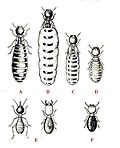Termite
Termites are a suborder of social insects, the Isoptera. They are sometimes called "white ants", incorrectly, because ants belong to the Order Hymenoptera.
| Termite Temporal range: Upper Triassic – Recent
| |
|---|---|

| |
| Formosan subterranean termite soldiers (red colored heads) and workers (pale colored heads). | |
| Scientific classification | |
| Kingdom: | |
| Phylum: | |
| Class: | |
| Subclass: | |
| Infraclass: | |
| Superorder: | |
| Order: | |
| Suborder: | Isoptera
|
They are eusocial animals, as are ants and some bees and wasps. Termites mostly feed on detritus, mostly wood, leaf litter, soil, or animal dung. There are an estimated 4,000 species (about 2,600 taxonomically known). About 10% are pests which can cause serious structural damage to buildings, crops or plantation forests.
Termites are major detrivores in the subtropical and tropical regions. Their recycling of wood and other plant matter is very important for ecology.
A termite colony starts when winged termites (called alates) swarm and mate. After mating, they fall to the ground and rip off their wings. The female looks for a good place to start the colony, and the male follows her. Most termites nest underground their entire lives, but termites in Africa and Australia actually build really big mound structures that look like little mountains and can be more than 20 feet tall (see photo below).
Termites live in colonies that, at maturity, hold from several hundred to several million individuals. They are a prime example self-organised systems which use swarm intelligence. They use this cooperation to exploit food sources and environments which would not be available to any single insect acting alone. A typical colony contains nymphs (semi-mature young), workers, soldiers, and reproductive individuals of both genders, sometimes containing several egg-laying queens.
Termite Media
The external appearance of the giant northern termite Mastotermes darwiniensis is suggestive of the close relationship between termites and cockroaches.
General anatomy of a worker termite with Imago (reproductive) and soldier visualized; note the reduction and fusion of sclerites on the thorax and more membranous body compared to other Dictyoptera. Mandible descriptive terminology on the bottom right. The fontanelle is absent in basal termites, being found only in Neoisopteran termites.
Diagram showing a wing, along with the clypeus and leg
A young termite nymph featuring visible wing buds. Nymphs mainly develop into alates.
Egg grooming behaviour of Reticulitermes speratus workers in a nursery cell
Termite workers at work
Other websites
| Wikispecies has information on: Isoptera. |
- Termitehub [1] Archived 2016-04-14 at the Wayback Machine








